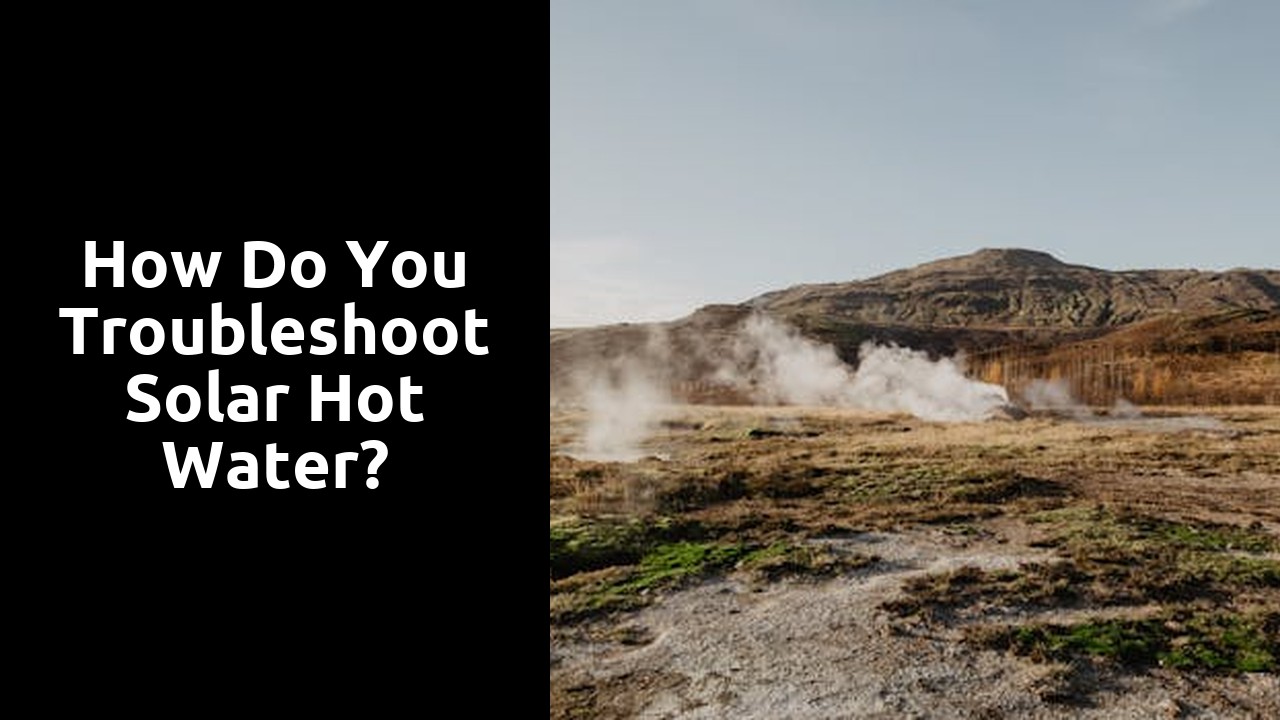
Inspecting the plumbing connections for leaks or damage
Inspecting the plumbing connections for leaks or damage is a crucial step in the process of troubleshooting a Solar Hot Water System. Begin the inspection by carefully examining all the joints and fixtures for any signs of water leakage. Leaks can not only lead to water wastage but also result in a decrease in the system's efficiency over time. Moreover, leaks can potentially cause damage to the property if left unattended.
Next, ensure that the pipes are in good condition and free from any visible damages such as cracks or corrosion. Pay special attention to areas where the pipes meet, as these are common places for leaks to occur. By conducting a thorough inspection of the plumbing connections, you can detect any issues early on and prevent further damage to your Solar Hot Water System.
Tightening loose connections and repairing any damaged pipes
If you are facing issues with your solar hot water system, it's essential to inspect the plumbing connections for any leaks or damage. Begin by visually examining all the connections and pipes for any signs of wear or leaks. Tighten any loose connections that may be causing leaks, as these can significantly impact the system's efficiency. If you notice any damaged pipes during the inspection, it is crucial to repair them promptly to prevent further complications. This step is a fundamental part of Solar Hot Water System Troubleshooting and can help restore the system's functionality.
Regular maintenance of the plumbing connections in your solar hot water system is imperative for its optimal performance. By ensuring all connections are secure and repairing any damaged pipes, you can prevent potential leaks and system malfunctions. Take the time to tighten loose connections to prevent water wastage and maintain the system's efficiency. Additionally, promptly repairing any damaged pipes will extend the lifespan of your solar hot water system and ensure it continues to function effectively. As part of Solar Hot Water System Troubleshooting, focusing on the integrity of the plumbing connections is crucial for the overall performance of the system.
Verifying the performance of the heat exchanger
Verifying the performance of the heat exchanger is crucial when troubleshooting a Solar Hot Water System. The heat exchanger is a vital component responsible for transferring heat from the solar collectors to the water. To ensure its optimal functioning, start by checking the temperature difference between the inlet and outlet pipes of the heat exchanger. A significant variance in temperatures could indicate a potential issue within the heat exchanger that needs attention.
In addition, inspect the heat exchanger for any signs of corrosion or mineral buildup that can impede its efficiency. Thoroughly clean the heat exchanger using a descaling solution to remove any deposits that might be hindering the heat transfer process. Regular maintenance of the heat exchanger will not only improve the performance of your Solar Hot Water System but also extend its lifespan.
Cleaning the heat exchanger to improve efficiency
Cleaning the heat exchanger is a crucial step in improving the efficiency of your solar hot water system. Over time, the heat exchanger can accumulate dirt, debris, and mineral deposits, hindering its ability to transfer heat effectively. To tackle this issue, you can use a non-abrasive cleaner specifically designed for heat exchangers. Gently scrub the surfaces to remove any buildup and ensure optimal heat transfer within the system. Regular cleaning of the heat exchanger will not only enhance the performance of your solar hot water system but also prolong its lifespan.
By maintaining a clean heat exchanger, you can maximise the energy efficiency of your solar hot water system. Improved heat transfer results in a more effective heating process, reducing energy consumption and ultimately lowering your utility bills. Make it a part of your regular maintenance routine to inspect and clean the heat exchanger to guarantee the smooth operation of your system. This simple yet crucial task plays a significant role in ensuring the continuous and efficient performance of your Solar Hot Water System Troubleshooting.
Testing the backup heating system functionality
Testing the backup heating system functionality is a crucial step in the process of Solar Hot Water System Troubleshooting. To ensure that the backup heating element is working correctly, start by examining the control panel to confirm that the settings are adjusted appropriately. Next, activate the backup heating system and check if the water temperature rises as expected. Make sure to monitor the system for any unusual noises or malfunctions during operation. If the water fails to heat up adequately, it might indicate a problem with the backup heating element that requires further inspection and potential repairs.
In addition to checking the functionality of the backup heating element, it is essential to verify that the backup heating system can kick in when needed. Test the automatic switch-over mechanism by simulating a scenario where the solar energy is insufficient to heat the water to the desired temperature. By ensuring that the backup heating system activates promptly and effectively, you can guarantee uninterrupted hot water supply even during periods of low solar energy generation. Regularly assessing the backup heating system's functionality is a proactive approach to maintaining the efficiency and reliability of your solar hot water system.
Ensuring the backup heating element is working correctly
Ensuring the backup heating element is working correctly is crucial when troubleshooting issues with your solar hot water system. The backup heating system serves as a failsafe during periods of insufficient sunlight to heat the water adequately. To verify its functionality, first, check the power supply to the backup heating element. Ensure that it is receiving power by examining the circuit breaker or fuse box. If power is reaching the element, proceed to test the heating element itself. This can be done by using a multimeter to measure the resistance across the terminals of the element. If the resistance reading is within the expected range, the heating element is functioning correctly. If the reading is outside the normal range, the element may need to be replaced to restore the system to optimal operation.
Regularly testing the backup heating system functionality is essential in maintaining the overall efficiency of your solar hot water system. A malfunctioning backup heating element can lead to decreased performance and potentially cold water during times of low solar input. By including this step in your routine maintenance checks, you can identify any issues early and address them promptly. It is recommended to perform these tests at least once a year to ensure that the backup heating system is ready to provide reliable support when needed. Remember, a fully functional backup heating element is a key component of a robust and reliable Solar Hot Water System Troubleshooting routine.
FAQS
How do I know if my solar hot water system is working properly?
You can inspect the plumbing connections for leaks or damage, verify the performance of the heat exchanger, and test the backup heating system functionality to troubleshoot any issues. ####
What should I do if I find leaks or damage in the plumbing connections of my solar hot water system?
Tighten loose connections and repair any damaged pipes to prevent further issues with your solar hot water system. ####
How can I improve the efficiency of the heat exchanger in my solar hot water system?
Cleaning the heat exchanger regularly can help improve its efficiency and ensure optimal performance of your solar hot water system. ####
In what situation should I check the functionality of the backup heating system in my solar hot water setup?
It is essential to test the backup heating system functionality to ensure it is working correctly and can provide hot water when needed. ####
What steps should I take to ensure the backup heating element is working correctly?
Regularly test the backup heating system, ensure the heating element is functioning as intended, and address any issues promptly to maintain the reliability of your solar hot water system.
